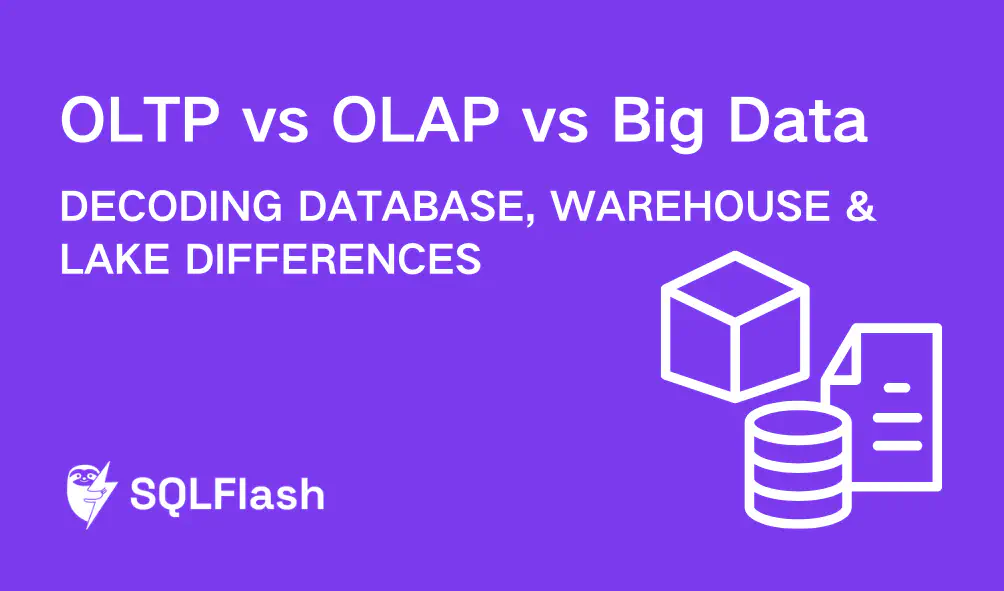OLTP vs OLAP vs Big Data: Decoding Database, Warehouse & Lake Differences


Database administrators face an ever-growing challenge: managing the explosion of data. You need the right tools and strategies. This article breaks down three key approaches for data management: Online Transaction Processing (OLTP), Online Analytical Processing (OLAP), and Big Data. We explain how each system works, highlighting that OLTP excels at real-time transactions with high throughput and OLAP helps you unlock insights through in-depth data analysis. By understanding their differences, you can choose the optimal solution for your specific needs and ensure your organization makes data-driven decisions.
The world is making more data than ever before! 🚀 From online shopping to social media, we’re constantly creating information. Managing all this data can be tricky. That’s why we have different ways to handle it.
This article will explore three main approaches: OLTP, OLAP, and Big Data. Each one helps us work with data in a unique way. We’ll also learn about databases, data warehouses, and data lakes, which are key tools for storing and organizing information.
Think about how much data is created every minute. It’s a lot! Companies need ways to store, organize, and use this data to make smart decisions. That’s where OLTP, OLAP, and Big Data come in. They are like different tools in a toolbox, each designed for a specific job.
Let’s define some key terms:
| Concept | Description | Example |
|---|---|---|
| Database | Organized data for specific purposes, often transactional. | A customer database with names, addresses, and order history. |
| Data Warehouse | Centralized storage for analysis and reporting. | Combining sales data, marketing data, and customer data for analysis. |
| Data Lake | Storage for raw, unstructured, or semi-structured data. | Storing social media feeds, sensor data, and log files. |
Choosing the right data management strategy is super important. Using the wrong tool can lead to slow performance, inaccurate insights, and wasted resources. ⚠️
🎯 In today’s data-driven world, choosing the right data management strategy is crucial. Let’s break down the differences between OLTP, OLAP, and Big Data to help you make informed decisions. We will explore the key differences between these approaches, focusing on their respective strengths and use cases. Get ready to dive in! 💡
Big Data is like a giant puzzle made of many different pieces! 🧩 It’s when we have so much information that regular computers and databases struggle to handle it. This data is often messy and doesn’t fit neatly into rows and columns.
Big Data refers to extremely large and complex sets of information. ⚠️ These datasets are too big and complicated for traditional database tools to easily process or analyze. Think about all the posts, pictures, and videos on social media every minute! That’s Big Data.
Big Data isn’t just about size. We often describe it using the “Vs”:
Some people also add these “Vs”:
| V | Description | Implication for Data Management |
|---|---|---|
| Volume | Huge amounts of data | Requires scalable storage and processing solutions. |
| Velocity | Data arrives at a rapid pace | Demands real-time or near real-time processing capabilities. |
| Variety | Data comes in different formats (structured, semi-structured, unstructured) | Needs flexible data models and processing techniques. |
| Veracity | Data quality and accuracy | Requires data cleaning and validation processes. |
| Value | The potential insights and benefits that can be derived from the data | Justifies the investment in Big Data technologies and analysis. |
Because Big Data is so big and complex, we need special tools to handle it. Here are a few:
When dealing with Big Data, we often talk about data lakes and data warehouses.
| Feature | Data Lake | Data Warehouse |
|---|---|---|
| Data Type | Raw, unstructured, semi-structured, structured | Structured, processed |
| Schema | Schema-on-read (structure applied during analysis) | Schema-on-write (structure defined before data is loaded) |
| Purpose | Exploration, discovery, advanced analytics | Reporting, business intelligence |
| User | Data scientists, analysts | Business users, executives |
A data lake is great for exploring new data and finding hidden patterns. A data warehouse is better for generating reports and making business decisions.
Big Data can help in many ways:
SQLFlash is your AI-powered SQL Optimization Partner.
Based on AI models, we accurately identify SQL performance bottlenecks and optimize query performance, freeing you from the cumbersome SQL tuning process so you can fully focus on developing and implementing business logic.
Join us and experience the power of SQLFlash today!.